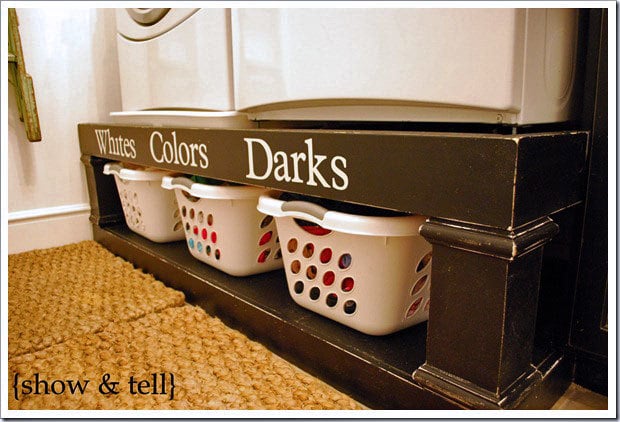
Build your own washer and dryer pedestal bases to bring your laundry up in height. Also includes storage for baskets. You'll love the step by step diagrams and cut list.
Dimensions
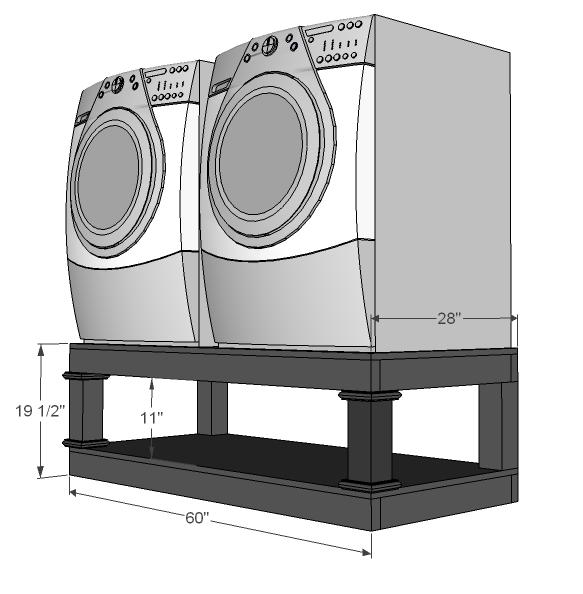
Dimensions shown above. Measure your laundry machines and adjust to fit. Also note the size under the bases can be adjusted for laundry basket heights by simply changing the cuts of the 4x4 legs.
Preparation
Shopping List
- 2 – sheet of 3/4″ MDF or Plywood
- 5 – 2×4 @ 8 feet long
- 1 – 4×4 post @ 4 feet long (you can also use 2x4s laminated together – just add another 2×4 to your list)
- 1 – stick of base cap moulding like this @ 6 feet long and 1" brad nails for attaching
- 4 – Angle Brackets (like these)
- 3″ self tapping wood screws
- 2″ self tapping wood screws
Cut List
- 10 – 2×4 @ 25″ (Joists)
- 4 – 2×4 @ 60″ (Sides of Floor)
- 2 – 3/4″ Plywood or MDF @ 28″ x 60″ (Decking)
- 4 – 4×4 Posts (or 8 2x4s) @ 11″ (Posts)
- Moulding cut to fit
Instructions
Step 1
Floors
You are basically going to build two mini floors for this project. The top floor need to be built as shown above.
The bottom floor you can skip the center joists (minimal weight on bottom shelf)
Use glue and 3″ self tapping screws to build the framing. You can also use pocket holes if you have a Kreg Jig, on the 1-1/2" setting with 2-1/2" pocket hole screws.
Step 3
Step 4
Step 5
Step 7
Additional Bracing
If you find your base needs more support here are a few quick fixes -
- Cover the entire back in 3/4" plywood or MDF scraps from the build, glue and screw every 4" approximately to the 4x4 legs and the 2x4 framing with 3" self tapping screws.
- Attach the 2x4s framing to studs in the walls
Finishing Instructions
Finish Used
Sausha trimmed everything out with another layer of MDF. If you are good with a table saw this can really give you that finished look. Otherwise, I recommend patience, and a whole tub of wood filler. More details on Sausha’s finish here.
Thanks Sausha!
Thanks Sausha!
Project Type




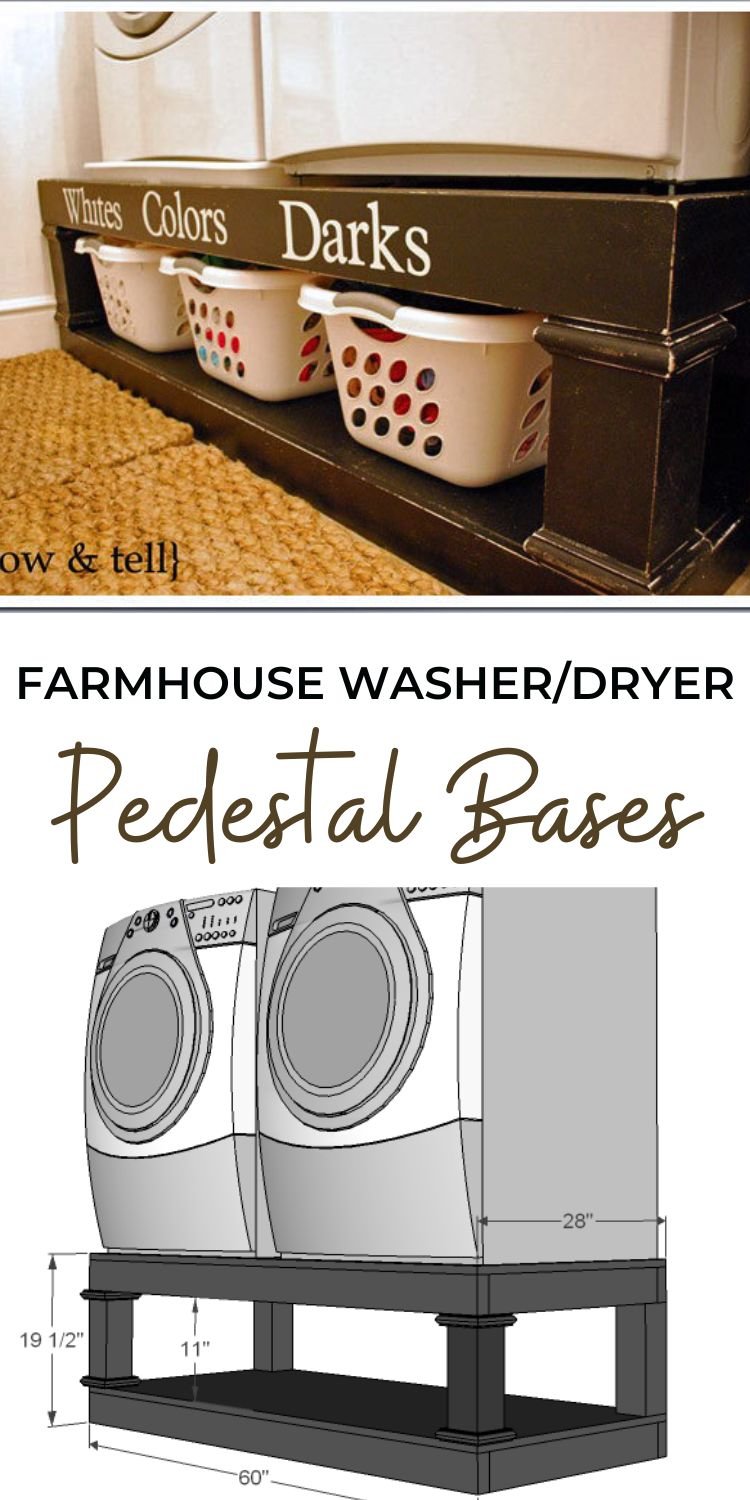













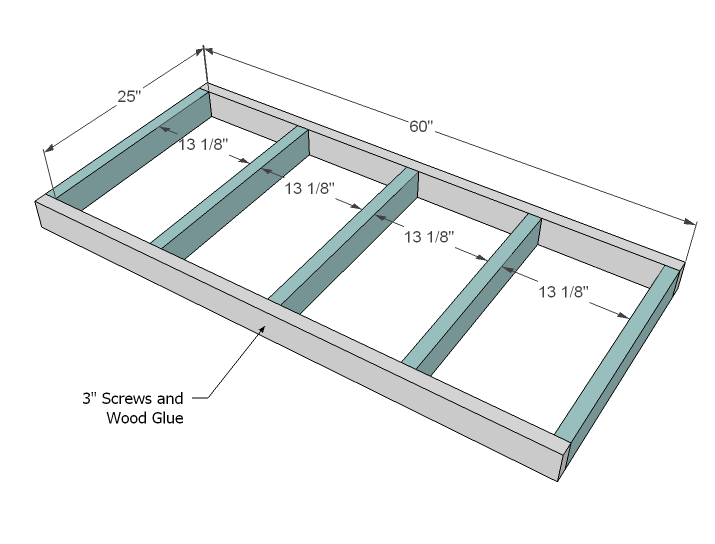
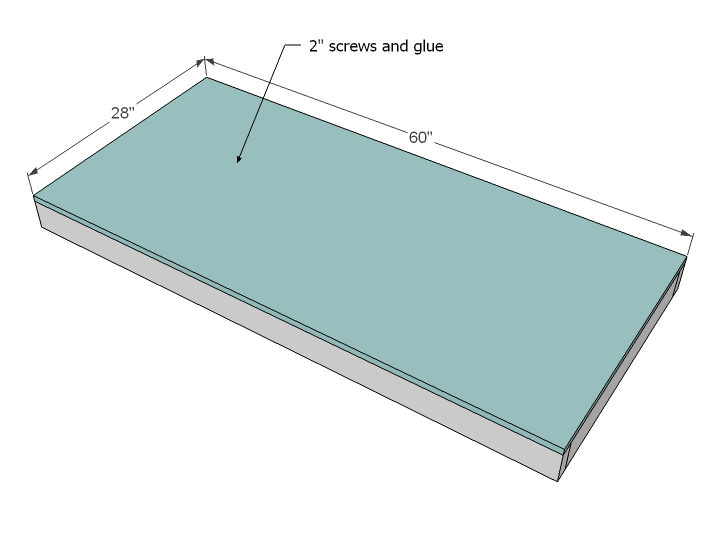

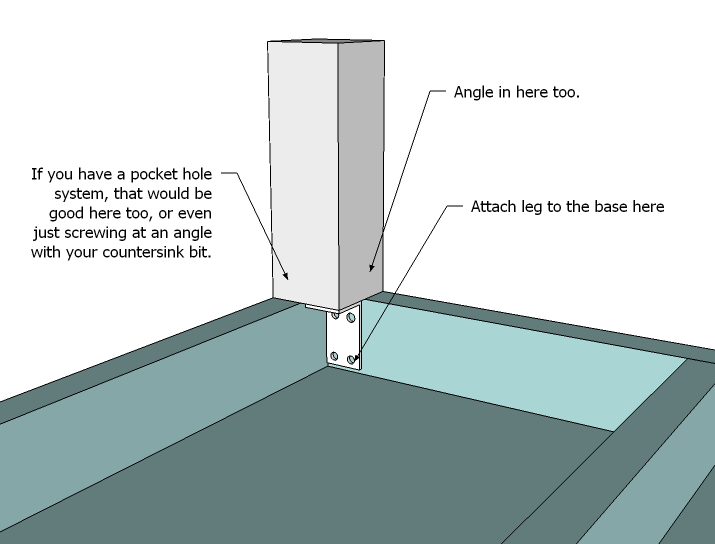

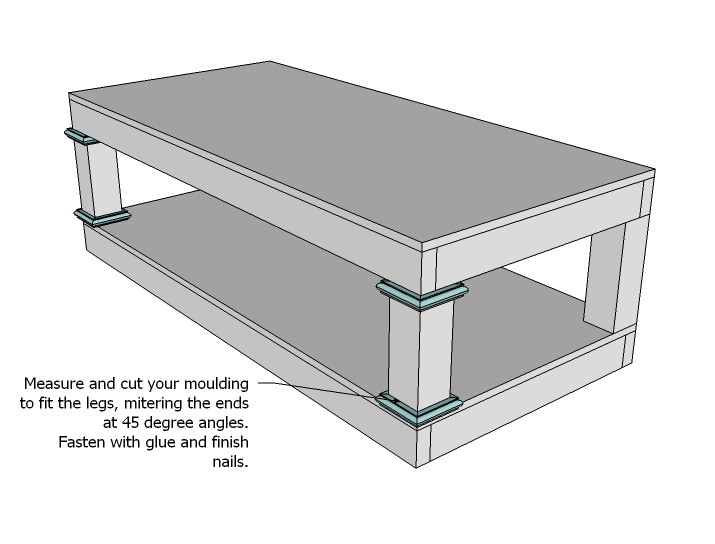
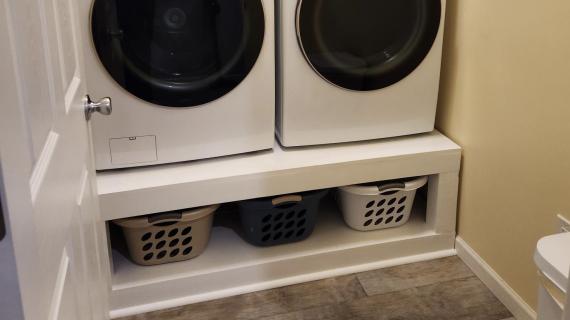
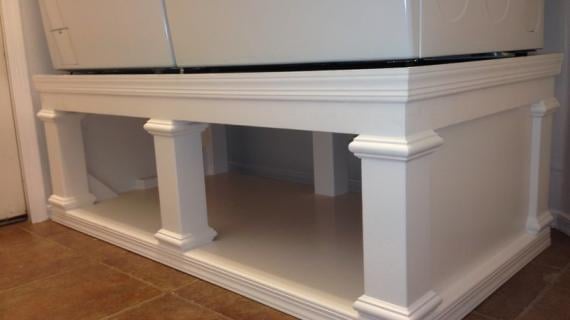
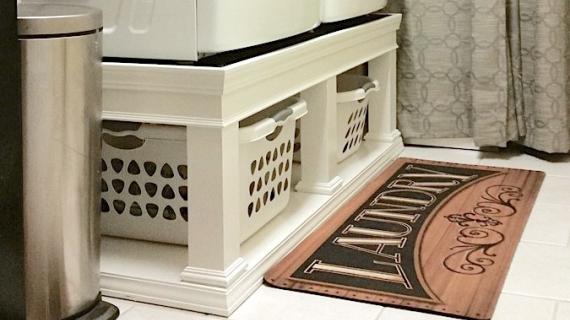
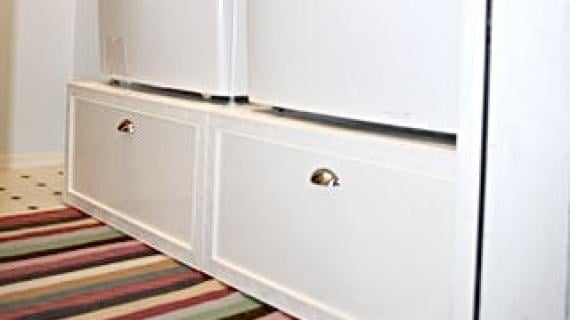
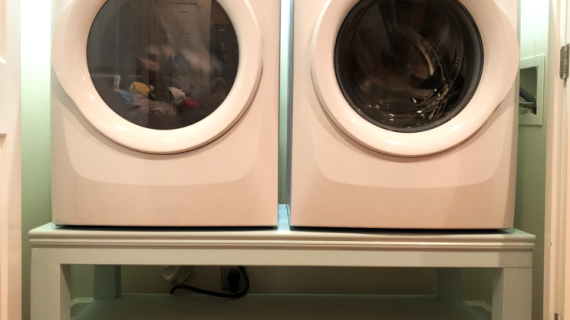
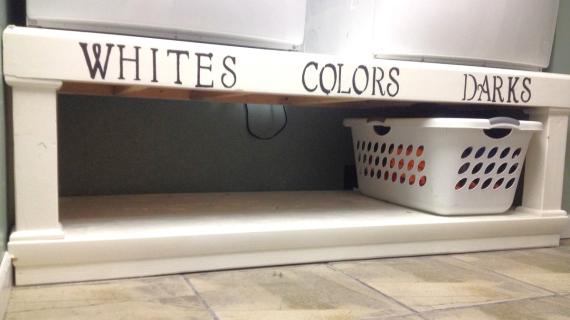
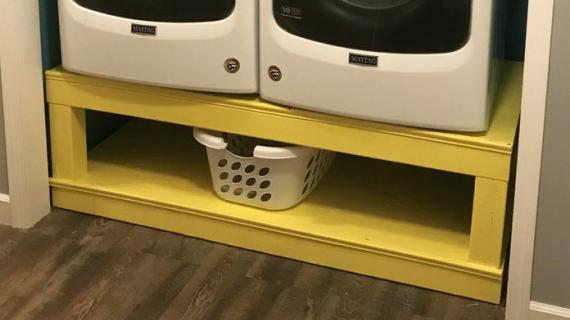
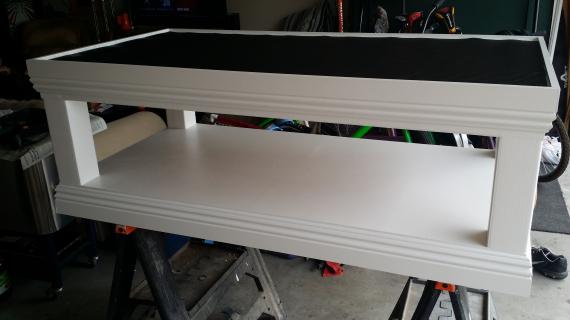
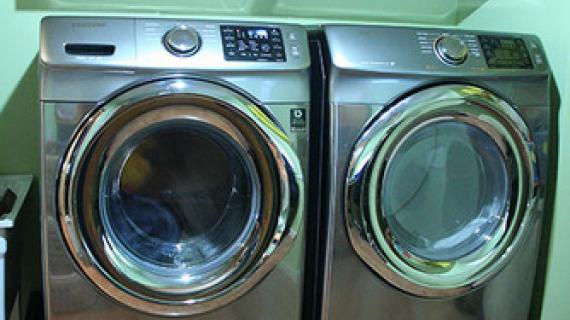

Comments
TheWorldMovesForLove (not verified)
Wed, 01/26/2011 - 20:49
Oh my gosh! DUH- why wouldn't
Oh my gosh! DUH- why wouldn't you use your pedestals for laundry baskets?? I've been wanting to build pedestals, but now I can't decide if I would prefer the storage for sheets, towels and blankets, or if I want space for laundry baskets!
Anne (not verified)
Wed, 01/26/2011 - 20:57
Wow, I never knew a laundry
Wow, I never knew a laundry room could be beautiful!
Tanjia (not verified)
Wed, 01/26/2011 - 21:03
Thanks for the hack, Ana! I
Thanks for the hack, Ana! I got some more great ideas from that blog about how to make my laundry room a little less... ugly.
Dana (not verified)
Wed, 01/26/2011 - 21:11
Thank you for the plans. I
Thank you for the plans. I saw her pedestals and loved them and this will give us no excuse to not build them. Except that the old washer and dryer keep on chugging along. Well only one cycle still works on each but the clothes do get clean. I think I might just have to consider the change in machines so that I can build these perfect pedestals.
christy (not verified)
Wed, 01/26/2011 - 21:50
ohhhhhh....thank you!!! i
ohhhhhh....thank you!!! i LOVE this!!! And my laundry room is soooo small - this will be perfect!! never too many spaces to tuck away laundry!!!!
Blessings to you!
~Christy :0)
Sharon Lambirth (not verified)
Thu, 01/27/2011 - 00:02
Love this idea! I am planning
Love this idea! I am planning a laundry room/ half bath and this is great if I decide not to stack my machines! I am thinking people could make a matching tabletop for over the machines as well if you have front loaders.
Karlee (not verified)
Thu, 01/27/2011 - 00:36
That looks way better than
That looks way better than those little drawers!
Leslie C (not verified)
Thu, 01/27/2011 - 02:06
i love it!!! We just bought
i love it!!!
We just bought new front loaders.
Sadly ours are in the garage and are across from each other!
Could there be a modification to make 2 separate ones?
Sharon L (not verified)
Tue, 04/12/2011 - 15:55
of course! As Ana states,
of course! As Ana states, just measure for YOUR space and YOUR machines..I would love to see separate ones, cool idea!
guest (not verified)
Sun, 09/11/2011 - 12:30
with your washer/dryer across
with your washer/dryer across from each other, maybe, if you have the space, you can make each pedestal a little wider, so each one gives you space for 2 baskets, and you could add some shelves along the sides of each machine for even more storage!
Whitney Smith (not verified)
Thu, 01/27/2011 - 02:47
Yup yup yup. I loved this
Yup yup yup. I loved this from the first moment I saw it on Sausha's blog. I have big dreams for my laundry room. Why shouldn't it be pretty when I spend hours in there each day!?
nichole (not verified)
Thu, 01/27/2011 - 02:50
Wow! Okay if her laundry
Wow! Okay if her laundry room really looks like that I am just amazed. Those are my favorite pedestals I have seen yet. Oh, if they come out with pink front loaders I may just have to go into debt. ;-) I love your site. I haven't built anything yet, but hope to soon.
Ann (not verified)
Thu, 01/27/2011 - 03:08
I've seen the countertop over
I've seen the countertop over the front-loaders in This Old House magazine and it looked fabulous! I'd do it if my laundry area wasn't sequestered to a far corner of my unfinished basement! Someday I dream of a laundry/pantry room on my main floor...
savvylili (not verified)
Thu, 01/27/2011 - 03:23
That is a great idea! though
That is a great idea! though I think I'd prefer to use the space for rarely used blankets, sheets, etc.
Heather (not verified)
Thu, 01/27/2011 - 03:48
Oh my......I've in love. I
Oh my......I've in love. I can't wait until we get to move our current laundry location to the new laundry room we plan on building. This is a must do. Maybe I can even convince that hubs that I "need" new front loaders. Sooooo cool!!
Lori (not verified)
Thu, 01/27/2011 - 04:02
Do you worry about the weight
Do you worry about the weight and movement of the washer / dryer? I'm sure my husband would balk at my making this due to that worry.
guest (not verified)
Sun, 09/11/2011 - 12:33
with the upper platform floor
with the upper platform floor built with the exact same construction as a house, I would think the weight would be the same as if they were on the floor. Does your washer "walk" when it spins? If it does, it's out of balance, and you can fix that with the feet. If your floor is uneven, here's your chance to give your washer a level floor to rest on!
Melanie34built (not verified)
Sat, 06/16/2012 - 19:57
Weight
I have had mine built for over 8 months and have had no problem with the weight. It is one sturdy plan. I had trouble once when my machine got out of balance, redid the feet with a level and got it all perfectly level and back to no issues. I LOVE the basket space and my laundry room is prettier, tidier and more functional, what more could a girl ask for!?
Kari (not verified)
Thu, 01/27/2011 - 04:02
Thank you Ana and Sausha!!!
Thank you Ana and Sausha!!! This is definitely going on the to-do list beside the craft organizer to make the craft room/laundry room/storage room a more peaceful place to be.
Faith (not verified)
Thu, 01/27/2011 - 04:19
Oh Ana! I've been dreaming
Oh Ana! I've been dreaming of this since I first saw it on Sausha's blog almost a year ago. I looked at her construction photos and just did not feel confident that I could construct it without more detail on measurements and the process. I am beyond excited! I definitely see a laundry room makeover coming my way soon! Thanks Ana and Sausha!
Tsu Dho Nimh (not verified)
Thu, 01/27/2011 - 04:49
AWESOME! You can just pull
AWESOME! You can just pull the basket out and dump it into the washer!
Carol Ann Sandell (not verified)
Thu, 01/27/2011 - 04:54
I love this! Makes so much
I love this! Makes so much sense!
Jaime Perreca (not verified)
Thu, 01/27/2011 - 05:07
Very nice. Ana, I also have
Very nice. Ana, I also have the old top loader. Another benefit of top loaders is the water level. I use Cloth Diapers and it takes a good amount of water to soak and wash them. Also those really dirty man jeans. :)
Stacey Gray (not verified)
Thu, 01/27/2011 - 05:22
Wow, you are a genius! I too
Wow, you are a genius! I too have the old top loader and dream someday of having a beautiful front loader. I have always been so overwhelmed by the cost though. And I always factored in the cost of the pedestals too (because everyone told me you HAVE to get the pedestals), which by the way are ridiculously expensive... But with this you can have a pedestal that not only looks TONS better, but is cheaper-who doesn't love that?
judi (not verified)
Thu, 01/27/2011 - 05:43
This is so awesome!
This is so awesome! Tragically my laundry room is set up so that the utility sink sits in between the washer and dryer. Still, I'm putting this idea in my mental file cabinet for the future.
keristeckler (not verified)
Thu, 01/27/2011 - 05:47
this is perfect for my
this is perfect for my laundry room shoe problem!!!!
Anna (not verified)
Thu, 01/27/2011 - 06:01
I just went and priced a new
I just went and priced a new front loading washer and dryer for our new house we are purchasing. The matching pedistals are $300 a pop.. ugghh I would much rather spend the $600 on something more fun than 2 drawers. I told my husband last night we should just build a platform for them... Sometimes I think it is fate when I look at your site every morning!
Pam the Goatherd (not verified)
Thu, 01/27/2011 - 06:04
Speaking as the wife of an
Speaking as the wife of an appliance repair person I want to emphasize that these pedestals should NOT be used for a top load washer!!!!!!!!!!!!!!! A top load washer will walk right off of the pedestal! I don't even want to imagine the mess that would make!!!
orangesugar (not verified)
Thu, 01/27/2011 - 06:05
I'm also wondering about
I'm also wondering about washer movement and them possibly falling off the front. It probably wouldn't be too difficult to build up a ledge on the front in order to avoid that from happening though.
flydoos (not verified)
Thu, 01/27/2011 - 06:48
I don't know about cloth
I don't know about cloth diapers but my mom had a top loader and then got a front loader and the front loader cleaned my step dad's clothes a lot better, he was a roofer. They would come out looking brand new. I take clothes that have stains I can't get out with my top loader to her house and they come right out without doing anything extra. I have 3 kids so I dream of front loaders all the time so I could do less laundry... :)
Sausha @ {show… (not verified)
Thu, 01/27/2011 - 07:50
Thanks again Anna for the
Thanks again Anna for the plans - love them!!
And i can see some people are asking about the vibration - as long as your washer is level there are no issues (just make sure and adjust the little feet on the bottom)
I did build up a little ledge on mine just to make sure if they did go crazy they wouldnt fall off - so far so good - no movement at all!!!
AmyLynn (not verified)
Thu, 01/27/2011 - 08:24
LOVE!!!! I think I'm going to
LOVE!!!! I think I'm going to put this on the list for my craft room. I can picture baskets filled with fabric scraps and yarn instead of laundry baskets. I too have a top load washer and when we get the front load ones they'll be going in the 2nd floor bathroom closet because that's where *all* our bedrooms are and, as I tell my husband, I want it that way :)
Marlene (not verified)
Thu, 01/27/2011 - 08:52
HOW DO YOU DO THAT??? I have
HOW DO YOU DO THAT??? I have this written up on my blog with these exact photos. This is my next "have to make" project to get my laundry room done! Thank you, thank you, thank you Ana!!!!
Marlene (not verified)
Thu, 01/27/2011 - 08:55
How do you do that??? You
How do you do that??? You seem to always know what I need. I have these exact photos on my blog. This is my very next "have to make" project and you've done the plans. Thank you, thank you, thank you again Ana.
Lucy (not verified)
Thu, 01/27/2011 - 09:09
I must admit to a little
I must admit to a little skepticism about this, my front loader is 200+ pounds, and in the spin cycle literally vibrates the nails out of the walls. Is this going to hold up to that?
IAMSNWFLAKE (not verified)
Thu, 01/27/2011 - 10:23
Thanks!!!! It's such a great
Thanks!!!! It's such a great idea to help keep baskets organized, get more storage space plus the added benefit of bringing the washer and dryer to more waist friendly heights. I so appreciate not having to bend down so much. And it can be custom built to meet machines of any size and brand.
IAMSNWFLAKE (not verified)
Thu, 01/27/2011 - 10:32
Thanks!!! It's so nice to
Thanks!!! It's so nice to have extra space for the baskets and boxes with the added bonus of bringing the washer and dryer to more waist friendly heights. I appreciate not having to bend down so low to load and unload the appliances. Love the idea that it can be custom built to meet machines of any sizes and brands.
Joshthepants (not verified)
Thu, 01/27/2011 - 12:23
This is cool, I showed it to
This is cool, I showed it to my wife and she decided that I get to build it this weekend. Should be fun.
Karen (not verified)
Thu, 01/27/2011 - 12:32
I love these, but my hubby is
I love these, but my hubby is worried because it doesn't have a center support. Makes me wonder - how DOES it support itself from the middle?
MichaelB (not verified)
Tue, 09/27/2011 - 12:48
Center support...
From the look of the plans, the base and top are torsion boxes. Very strong when you make a frame and skin it with plywood (I would use that for more rigidity). You can make it even stronger by skinning both sides with plywood.
Hope that helps.
Michael
Larry (not verified)
Sun, 12/16/2012 - 01:50
Strengthening the Pedestal
I agree with Michael. Making the top platform of the pedestal a torsion box, with plywood on the top and bottom, will add considerable strength. To save money, the bottom of the torsion box, could be a thinner plywood . I would go with 1/2 inch plywood.
The top on the bottom platform could be thinner as well, considering that it wouldn’t carry much of a point load, except at the corners. Adding a short piece of 2x4, on edge, diagonally across all the corners at the ends of both frames to support the thinner plywood would solve that problem.
Finally, you will stabilize the whole assembly by adding some 1/2 inch plywood, between the top and bottom platforms, on the ends of the pedestal as well as on it’s back. The back piece doesn’t need to go all the way across the back. A short piece, on the back at each end will do fine.
Hope this helps.
Tiffany (not verified)
Thu, 01/27/2011 - 12:33
Beautiful pedestal- amazing.
Beautiful pedestal- amazing. One note of caution for those tempted to get a front-loader... if your laundry room is on the 2nd floor (as is common in CA) or on a floor that is NOT concrete (not on the slab or in the basement on the foundation), take a good look at the vibration the machine of your heart's desire creates- we have a front loader that has been on slab twice and on floor (over basement, so on joists) once. On the slab- it's a dream. On a joist floor- a nightmare. Shaking the house down! And a pedestal of any kind will just magnify the vibration and make it worse (lesson neighbor learned). The appliance stores won't tell you that little surprise- laundry-doer beware :) Some are supposed to be OK for vibration- do your research, please!
sheila (not verified)
Thu, 01/27/2011 - 12:59
I love it.
I love it.
Pam the Goatherd (not verified)
Thu, 01/27/2011 - 14:03
Ana, if your dryer is noisy
Ana, if your dryer is noisy it could be something as simple as needing a new idler pulley. They are inexpensive and easy to replace. I've changed them out all by myself, though it is easier if you have a partner to hold the drum in place while you put the belt back on.
Darla (not verified)
Thu, 01/27/2011 - 17:54
THIS is the answer to my
THIS is the answer to my problem of having nowhere to put the laundry basket dresser! Thank you Ana and Sausha!!
Andrea (not verified)
Fri, 01/28/2011 - 06:02
This is nothing short of
This is nothing short of amazing! I can't wait to make this. Right now our laundry basket lives in a tiny, tiny mud room... on top of the dryer, which makes sorting laundry challenging when you're only 5 ft tall!
Tiffany (not verified)
Fri, 01/28/2011 - 08:01
I asked this question on
I asked this question on facebook, but haven't had much response, so I thought I would ask here too. I was wondering if a person could use stock lumber like 1x8s or 1x10s for the sheeting on the tops of each level of this. I understand it may take some adjustments in measurements, but it would also make it easier to paint and/or distress without having to use a tub of wood filler. Since 1xs are 3/4 inch, wouldn't it be similar to 3/4 inch plywood?
Pookie's Mama (not verified)
Sun, 03/27/2011 - 16:35
pedestal topper for front load washer blog
Tiffany, just posted a comment about the top for the pedestal as well as some "anti-vibration" things to reduce vibration on a framed floor, I hope!
Loni (not verified)
Fri, 01/28/2011 - 09:59
I was just thinking I would
I was just thinking I would probably do that anyways just as extra precaution even though my machines don't "walk".
Jenny (not verified)
Fri, 01/28/2011 - 10:01
WOW! I might actually enjoy
WOW! I might actually enjoy doing laundry if my laundry room looked like that!